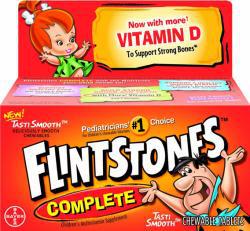Please send your questions for publication to gentlemanscholarslate@gmail.com. (Questions may be edited, or wholly invented.)
My 2-year-old is a super-picky eater, and my wife and I are freaking the fuck out about his intake of vitamins and minerals. What do you recommend?
Pills.
Consult a physician, but it should set your mind at ease for the kid to take half of a Flintstones chewable multivitamin each day and for you and the missus each to take half of a 2mg Xanax ASAP.
Why Flintstones?
The short answer is brand loyalty.
What’s the long answer?
Giving you a long answer will require summarizing the first chat my kid and I had about Fred Flintstone, and you know what it’s like trying to talk to someone whom you are actually trying to talk some sense into. You say to the 2-year-old, “How old are you?” and he stonewalls, pretending to absorbed in his choo-choo. You say, “How old did you turn on your birthday?” and he says, “I want cake.” I’ll give you the long answer after you take the Xanax.
…
Are you back? Once upon a time—some weeks ago, late in the morning and the year, out running errands in the mass-marketplace—I was ambushed into sentience by television, to use a John Leonard phrase. I’d walked into the pharmacy remembering that we had nearly run out of vitamin supplements for the baby, so I pivoted to the correct shelf, stooped to survey the dropper bottles—and only then realized that we had completely run out of baby. We had aged out of the baby-bird business of the dropper bulb, and our toothsome child was ready for exciting new challenges.
I cast a fresh eye at the shelf. There were chewables and there were gummies, and there was a cartoon cavalcade of licensing deals—a Pixar Cars convoy and a Disney princess clique, a poor depressive Pooh and a poriferous manic SpongeBob, an old-school minimalist Mickey and a panderingly contemporary skateboarding Bugs. There was, on the box of the perfectly decent value brand—a product as worthy as many of the above and marketed with more integrity than some—a motley menagerie of non-celebrity critters begging for love with the blank eyes of plush toys. But most of all there was no contest here.

Courtesy of Bayer/Amazon
Fronting a box of Flintstones Complete Chewables—his arms lifted in a vigorous V and all eight fingers splayed to tickle unknown recesses of memory—Fred Flintstone is a figure of soaring fun. On the drugstore aisle it seemed he had leapt to deliver a flying tackle of a fond hug. His expectant gaze warned he’d be let down if I did not reciprocate the embrace. I knew in my heart that it was a sales pitch—but also that Fred and his colleagues had installed in that heart a love for a pitch in itself.
I proceeded to checkout with Marty O’Donnell’s vintage jingle playing in one part of my head (“We are Flintstones kids—10 million strong and growing!”) while in another I reflected on that jingle and the 1987 commercial it rode in on: An unseen children’s chorus evokes a collectivist ethos that would not be out of place in North Korean propaganda, and its mewling coerciveness exemplifies the cultural bullying George W.S. Trow describes as “the aesthetic of the hit” (“It’s a Hit! Love it! … It loves you because you love it because it’s a Hit!”). All the while, the child actors featured at bowling alleys and in batter’s boxes and behind the double bass are awfully darn cute. In its combination of authoritarianism and kitsch, the old Flintstones ad campaign is in the style of Hummel-figurine fascism, I decided, while swiping my credit card.
That evening, as his dinnertime approached, I said to the kid, “Hey, kid, do you know who Fred Flintstone is?”
He raised his lake-wide eyes from the project of re-undismantling a toy car and not very convincingly said, “Yes.”
“Oh, do you really? Tell me who Fred Flintstone is.”
“Um,” said the boy, “a rabbit.”
I saw we had a lot of work to do. I said, “No, Fred Flintstone is a cartoon caveman by Hanna-Barbera. He used to have a TV show.”
He said, “I want to watch Elmo,” giving me what I deserved for putting the issue of television on the table. Years ago, I assessed Elmo as “a symbol of innocent joy peddled with the utmost cynicism”; now I regard him as a reliable accomplice for stealing 10 minutes for a shower.
“No, not tonight, but I ought to show you the opening of The Flintstones later,” I said, and continued to babble about how The Flintstones began in the early ’60s as an ABC prime-time show inspired by The Honeymooners. “Fred’s catchphrase is yabba dabba doo.”
He said, “I want to watch Yo Gabba Gabba,” referring to a current program, the success of which I attribute to its superficial funkiness, which allows parents to believe that they and their progeny are absorbing something less uncool than Dora the Explorer.
I chatted some more about Bedrock and Barney Rubble. He upended a box of Duplo blocks, letting go a cascading plastic clatter, a stochastic crash of chunky acoustics auto-echoic of innocent chaos. I kept going about how Bam-Bam, with his banging, was not a good role model and how Fred, not unlike Daddy, worked for Mr. Slate.
He said, “I want to watch Mickey Mouse.” We had never sat down to watch Mickey Mouse. This is just a phrase that American children say. Unless they live someplace like rural Montana or downtown Berkeley, they cannot avoid encountering him, and their brains are spongy, and the pop impact of the cartoon greats is undeniable.
For instance, when I showed the boy the vitamin box, he saw Fred and said, “Ameego.”
I said, “Amigo?”
He said, “Amingo!”
I said, “Amingo?”
He said, “L’Mingo.”
I said, “Did you say Flamingo?”
Long story short, a few weeks earlier, we had been through Las Vegas, which is the kind of place where, when in lieu of a full-fledged zoo outing, you can visit the Wildlife Habitat surrounding the wedding chapel at the Flamingo Hotel & Casino. If the kid hadn’t brought it up, I would have forgotten that Fred had some kind of presence near the valet stand.
I’m not certain why. It likely had something to do with the live-action film Flintstones in Viva Rock Vegas (2000), starring Game of Thrones’ Mark Addy as Fred. But he might have been promoting a slot machine, really. A review of the Flintstones’ merchandising résumé indicates a certain tendency toward innovative whorishness. It is sometimes supposed that “Yabba Dabba Doo” is an homage to the Brylcreem slogan “A little dab’ll do you,” and if the claim isn’t true, it should be. The introduction of the vitamins—in 1968, the year after NBC began airing The Flintstones on Saturday mornings—was perhaps Fred’s most wholesome marketing moment. A consumer of Pebbles cereals, for example, will never stand accused of being a food snob, fro-yo toppings aside. (Last month, Post Foods announced that pro-wrestler John Cena would be tagging in for Fred on the box fronts of Fruity Pebbles and Cocoa Pebbles. Could you imagine Randy Savage pitching Grape-Nuts?) And obviously you want to steer your children away from this black-and-white TV commercial, on account of Fred’s shabby grammar in asserting that Winston tastes good like a cigarette should.
I opened the box and looked at the vitamin bottle. Here was Fred again. His 5 o’clock shadow spotlighted the capacious grin of his gaping mouth, and his tongue was ready for liftoff, set to crow exultant yawps with much ado.
The kid took the bottle in hand and said, “I want to open it—I want to open it—I want to open it—I want to open it—I want to open it—I want to open it—I want to open it—I want to open it.”
I said, “You’re welcome to try, but it’s got a child-resistant cap, and you’re a child. The raison d’être of the cap is to resist you. It’d be tough.”
He said, “I want to open it, please.”
This attempt at courtesy deserved a reward, so I turned to YouTube and fired up The Flintstones’ intro, with its immortal jazzy jingle, properly called “(Meet) the Flintstones.” Composed by toon-tune maestro Hoyt Curtin on the model of George Gershwin’s “I Got Rhythm,” deliciously syncopated and unfailingly cheering, the Flintstones theme is a high point of children’s music. This is another reason to choose this brand of vitamins: It offers a context in which to begin entertaining your child with a classic song easily played on toy xylophone and delightfully elaborated upon by jazz guitarists, all of which sure beats the hell out of another round-and-round of “Wheels on the Bus.”
Moreover, the speed with which your child will adopt yabba dabba doo as a thing to say likely will inspire two levels of critical reflection: interrogating your own pop-cultural toddlerhood and reviewing his media diet. The latter will prove a useful exercise whether you forbid television entirely or are the type who will let the child hang out while you watch your own shows (until the day comes when, at the start of a DVRed crime drama, he says, “Why is that lady sleeping on the floor?”).
I leave you with one yabba-dabba-don’t: Introduce the vitamins at breakfast, not dinner. You are supposed to give the kid his vitamin with food, and as you say, toddlers do not reliably eat dinner. The low point of the evening I have described came soon after I abandoned trying to make the kid eat what I wanted him to eat and decided to settle for what he wanted to eat. But Daddy did not immediately remove the lid from the yogurt tub, and the kid, in an unprecedented tantrum, executed a leg press and flipped over the coffee table. Forget everything you’ve learned from reality television: You haven’t seen a table flipped until you’ve seen a 2-year-old do the job, which you can’t even see because it happens so fast. The kid was lucky that his mother wasn’t home. She would have screamed so much that the neighbors would have called the cops, and when they showed up, she would have pressed charges.
So it goes. He had a timeout, and he apologized. He had his yogurt and his chunk of Betty Rubble, and he got to hear “(Meet) the Flintstones” twice more, and I, thinking about that song’s jazziness, got to reflect on the art of improvisation, on how parenting is a perpetual improv class for itself.
Cool story, bro. But, hey, you said earlier I should give my kid half a vitamin. What’s up with that?
Half a tablet is the recommended dosage for 2- and 3-year-olds. Although children ages 4 and up—you and me, for instance—are allowed whole tablets, I recommend that you split the daily vitamin with the child: Your central incisors are the most convenient tools for bisecting the suckers, and giving ’stones in this manner is a delightful morning ritual—a secular sacrament for the Pop poppa.
